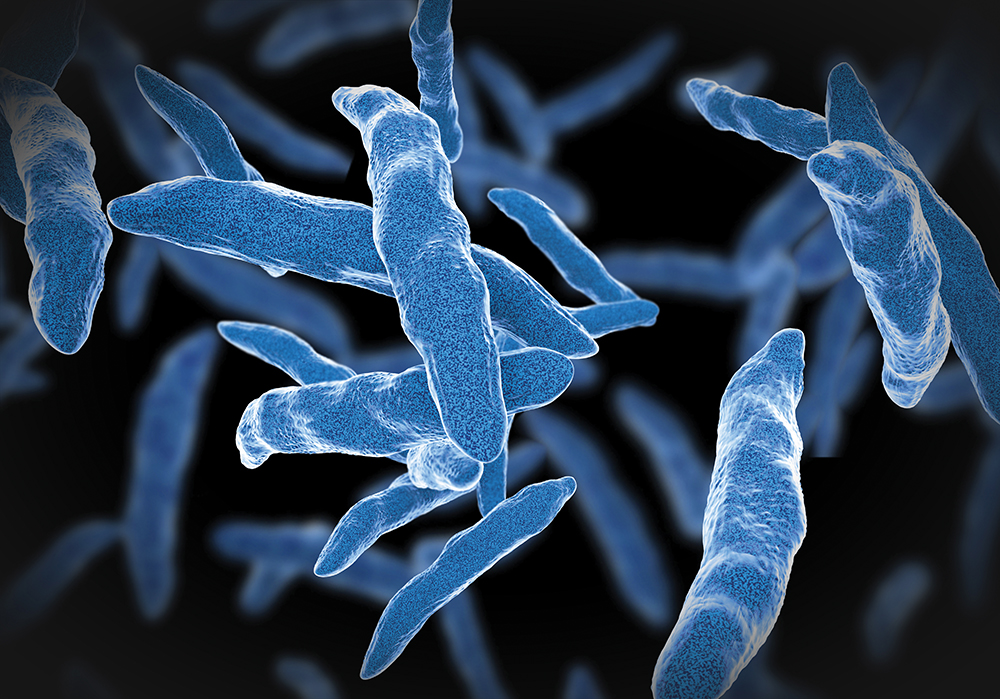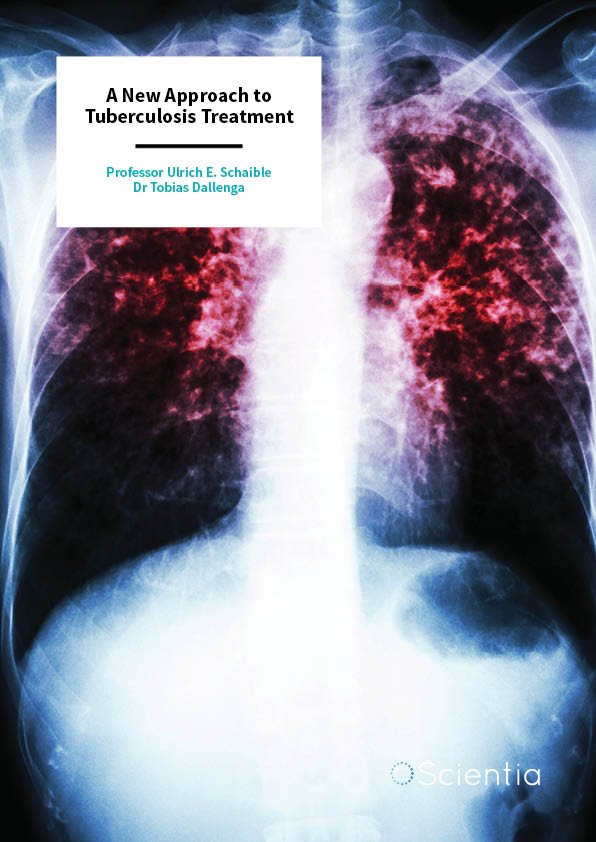Professor Ulrich E. Schaible | Dr Tobias Dallenga – A New Approach to Tuberculosis Treatment
With the growing challenge of antibiotic resistance, developing alternative treatments for tuberculosis is vital. Elegant research led by Professor Ulrich E. Schaible and Dr Tobias Dallenga at the Research Center Borstel in Germany suggests that innate host immune cells could be potential targets for an exciting new therapy for the disease.
Tuberculosis (TB) is the leading cause of death from infectious diseases worldwide. According to the World Health Organization, 10.4 million people worldwide contracted TB in 2016 alone, and 1.7 million died from complications related to the infection. Especially alarming is the rising numbers of cases of multi-drug and extensively drug-resistant forms of the disease, which constitutes half a million cases annually. For patients infected with extensively drug-resistant forms of TB, the survival rate is only 28%.
Presenting a major global healthcare challenge, the emergence of these resistant forms of the disease prompted the G20 leaders to single out TB within the emerging problem of antibiotic-resistant bacterial infections in their 2017 summit declaration.
The Importance of the Host Immune System
TB is caused by infection from a bacterium called Mycobacterium tuberculosis (or M. tuberculosis). Most infections of TB do not have symptoms, and these are known as latent tuberculosis. About 10% of latent infections progress to active disease, which if left untreated, kills about half of those infected. In its active form, the illness is characterised by a massive influx of inflammatory host immune cells into the lungs, followed by destruction and loss of tissue. This leads to the patient coughing up contagious particles, and the infection spreads from person to person through inhalation of the infectious particles.
One immune cell, in particular, has recently fallen into the spotlight of TB research: the neutrophil. Circulating in the bloodstream, these white blood cells represent the first line of defence against bacterial infections. Upon sensing signals that an infection is present, neutrophils quickly migrate to the infection site in large numbers to begin killing the invading germs.
‘We aim to design host-directed therapies to make antibiotic treatment more effective, to curb pathology and long-term lung damage and respiratory deficiencies of cured patients.’

Until recently, the role of neutrophils in TB has been poorly understood because they are hard to detect in commonly used animal models of the disease. In the last ten years, however, it has become apparent that many animal models do not accurately reflect the pathology of the disease in humans. In contrast, in human TB, neutrophils are the main infected cell type in the lungs of patients with active TB.
Professor Ulrich E. Schaible and Dr Tobias Dallenga at the Research Center Borstel set out to better understand the role of neutrophils in TB, and to explore the hypothesis that these white cells exacerbate TB pathology. The team’s ultimate aim is to find potential new treatments for the disease.
TB Induces Cell Death in Neutrophils
In an early set of experiments, the team infected human neutrophils with M. tuberculosis under laboratory conditions and found that although the neutrophils quickly engulfed large numbers of M. tuberculosis, they failed to kill the mycobacteria. Intrigued by their observation that these highly effective defence cells could not clear the M. tuberculosis infection, Professor Schaible and Dr Dallenga took a closer look at exactly what happens to the infected neutrophils. They found that human neutrophils isolated from the blood of healthy donors quickly succumbed to a certain type of cell death known as necrosis starting only six hours after infection with virulent M. tuberculosis under laboratory conditions.
The researchers found that this necrotic cell death is associated with release of both, neutrophil cell contents and M. tuberculosis, which were freed into the extracellular space. They showed that induction of this type of cell death was dependent on one specific small virulence factor, called ESAT-6, that contributes to the function of the bacterial secretion system ESX-1. Using a mutant version of M. tuberculosis lacking this virulence gene and therefore, lacking a functional ESX-1 secretion system, the team found that these mutant bacteria failed to cause neutrophil necrosis.
Interestingly, the team also found that M. tuberculosis-induced neutrophil necrosis was dependent on the neutrophil’s own generation of reactive oxygen species. Not only did they show that inhibiting reactive oxygen species prevented necrosis, but neutrophils from patients with impaired reactive oxygen species production were protected from necrotic cell death when infected with M. tuberculosis.
The team hypothesised that neutrophils provide a short-lived environment for M. tuberculosis bacteria. The vast influx of neutrophils, engulfment of M. tuberculosis, and subsequent neutrophil death appeared to provide a niche for the bacteria. Setting out to examine this further, they looked closely at what happened to neutrophils when infected with mutant M. tuberculosis that lacked ESX-1. Here, the neutrophils underwent default apoptosis (normal programmed cell death) similar to that seen in uninfected neutrophils.

TB Infection – A Vicious Cycle
The team’s finding that the type of neutrophil cell death – either apoptosis or necrosis – is determined by the virulence of the infecting M. tuberculosis agent, led the researchers to analyse the fate of M. tuberculosis-infected neutrophils in macrophages.
Macrophages are another type of white blood cell in the immune system, which engulfs and digests bacteria and other foreign substances, in a process called phagocytosis. These large protective immune cells are found throughout our body, and constantly patrol for potentially harmful threats. Professor Schaible and Dr Dallenga’s work showed that these cells play an important part in the fate of M. tuberculosis in disease.
Recently published work by the team in the journal Cell Host & Microbe reports that removing necrotic neutrophil debris together with virulent M. tuberculosis promotes the survival of M. tuberculosis and its proliferation in human macrophages. This was in contrast to apoptotic neutrophils infected with an attenuated mutant M. tuberculosis.
In this research, the team cultured human neutrophils and macrophages together under safe and carefully controlled laboratory conditions, known as cell co-culture. In this system of infected neutrophils and uninfected human macrophages, the latter became infected through taking up necrotic neutrophils.
Subsequently, only virulent M. tuberculosis bacteria were able to grow within these macrophages and, ultimately, also drove those into necrotic cell death. Notably, the team demonstrated that when they pharmacologically prevented neutrophil necrosis, virulent M. tuberculosis were not able to subsequently grow in macrophages.
Therefore, neutrophil necrosis is necessary for the growth of the infectious agent within macrophages. This starts a vicious cycle: the infected necrotic neutrophils are taken up by the macrophages, in which M. tuberculosis grows, leading to a necrotic cell death of the macrophages, the TB infection then spreads and the infection is maintained. The switch point, either necrosis or apoptosis, determines the subsequent fate of M. tuberculosis.

Controlling M. tuberculosis Growth
In the same paper, the team found that human neutrophils fail to kill virulent mycobacteria due to M. tuberculosis infection-induced production of reactive oxygen species, confirming their hypothesis that the reactive oxygen species production sends neutrophils into necrotic cell death – allowing M. tuberculosis to escape elimination. Notably, when necrosis of infected neutrophils was pharmacologically inhibited, the macrophages could then control M. tuberculosis growth by taking up infected neutrophils.
These data suggest that host cell necrosis, driven quickly upon infection of neutrophils, is beneficial for the fate of M. tuberculosis in the subsequent host cell, such as a macrophage. Consequently, interfering with neutrophil necrosis restored the ability of macrophages to control M. tuberculosis growth.
The researchers hypothesised that consecutive cycles of infection and host cell necrosis, interspersed with periods of M. tuberculosis proliferation, ultimately results in TB-associated tissue damage, which leads to coughing and the infection spreading. Excitingly, the team suggests that their results could lead to a novel host-directed therapy that could be used alongside antibiotic treatment to effectively control the illness, even with drug-resistant forms of M. tuberculosis.
Neutrophils as Therapeutic Targets for TB
The importance of neutrophils as markers for TB disease progression and their role in the pathology of TB makes them potential biomarkers for point-of-care diagnosis. Neutrophils can indicate disease severity and also enable treatment monitoring in patients with TB. As such, they also constitute a promising target for host-directed therapy. Here, a patient’s immune system is specifically influenced to mitigate potential tissue damage and deterioration of symptoms whilst restricting the spread of the bacteria.
‘We aim to design host-directed therapies to make antibiotic treatment more effective, to curb pathology and long-term lung damage and respiratory deficiencies of cured patients,’ Professor Schaible explains.
The team’s research focuses on identifying new targets to interrupt this vicious circle and re-equip the immune system with the ability to control M. tuberculosis infection. Excitingly, they are looking for suitable predictive diagnostic biomarkers to determine the correct time window and appropriate host-directed therapeutic drug. In this way, their aim is to develop a personalised precision medicine approach. ‘We are using our experimental tuberculosis models to screen a wide range of compounds currently either at the experimental stage, safety-approved for clinical trials, or clinically (FDA) approved stage – preferentially those that can be re-purposed as they are in routine clinical use for other diseases,’ Professor Schaible explains. Ultimately, neutrophils represent key targets for host-directed therapy in TB, a disease that remains a significant health challenge worldwide.
Meet the researchers

Professor Dr. rer. nat. Ulrich E. Schaible
Division of Cellular Microbiology
Research Center Borstel – Leibniz Lung Center
Borstel
Germany
Professor Ulrich E. Schaible completed his doctoral thesis at the Max Planck Institute of Immunobiology in Germany. Following postdoctoral studies in St. Louis and Berlin, he became Professor of Immunology at the London School of Hygiene & Tropical Medicine, UK, in 2006. Subsequently, he became Director of the Department of Molecular Infection Research at the Research Centre Borstel and Professor of Immunochemistry and Biochemical Microbiology at the University of Lübeck. Professor Schaible is currently Director of the Priority Area Infections, head of the Cellular Microbiology division at the Research Centre Borstel and chairman of the international Masters course in Infection Biology at the University of Lübeck. Professor Schaible has long-standing expertise in experimental infection research, evidenced through a list of over 125 publications and six patents.
CONTACT
E: uschaible@fz-borstel.de
W: http://www.fz-borstel.de/index.php/de/sitemap/programmbereich-infektionen/zellulaere-mikrobiologie-prof-dr-ulrich-schaible/mission#innercontent
W: http://www.tbsequel.org/personnel/ulrich-e-schaible/
W: http://www.leibniz-infections21.de/en/research/objectives-tasks/

Dr. rer. nat. Tobias Dallenga
Division of Cellular Microbiology
Research Center Borstel – Leibniz Lung Center
Borstel
Germany
Dr Tobias Dallenga is an infection biologist with a diploma in neuroanatomy from the University of Oldenburg. He spent several months as an intern at the Center for Molecular Neurobiology in Hamburg, Germany, before completing his doctoral studies in multiple sclerosis research at the Institute for Neuropathology, University Medical Center, Göttingen, Germany in 2011. He was appointed senior scientist and is now Deputy Group Leader of the division Cellular Microbiology at Borstel. Since 2015 he has been a lecturer in Molecular Life Science at the University of Lübeck. Dr Dallenga is co-founder and section officer of the Leibniz Postdoc Network, the first nation-wide association representing postdoctoral researchers, their needs, and careers, in Germany.
CONTACT
E: tdallenga@fz-borstel.de
W: http://www.fz-borstel.de/index.php/de/sitemap/programmbereich-infektionen/zellulaere-mikrobiologie-prof-dr-ulrich-schaible/mission#innercontent
W: https://www.linkedin.com/in/tobias-dallenga/
W: https://biography.omicsonline.org/germany/research-center-borstel/tobias-dallenga-834378
Twitter: @TDallenga
KEY COLLABORATORS ON THIS PROJECT
Professor Gareth Griffiths, Dr Urska Repnik, University of Oslo, Norway
Professor Alexander Apt, Professor Vladimir Yeremeev, Central Institute for Tuberculosis, Moscow, Russian Federation
FUNDING
German Science Foundation / Deutsche Forschungsgemeinschaft (SPP 1580, IRTG 1911, German-Russian Coproject)
German Ministry of Research and Education (ANTI-TB, Deutsches Zentrum für Infektionsforschung – TTU-TB, BMBF-Afrika TB-Sequel)
Leibniz Association (Leibniz Research Alliance INFECTIONS’21)


